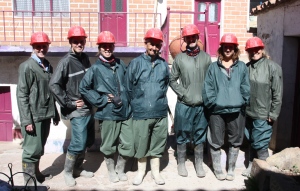The heartbreak of Rich Mountain
No one will ever know how many died working the silver mine in Potosi, Bolivia. Some say millions, which may be too high, but it certainly was in the thousands.
Cerro de Potosi—often referred to as Cerro Rico or Rich Mountain—was the mountain made of silver ore.
Legend has it that one night in the 1500s, a shepherd lit a fire on the mountain and a silver substance oozed out. The Spanish got wind of the news and descended on Potosi with greed and manpower.

Some of the mine at Cerro Rico
Potosi produced so much wealth it became one of the largest and richest cities in the Americas and the world. They say there was enough ore to build a bridge of silver from Potosi to Madrid, and then enough more silver to make it worth carrying it from one to the other.
That bridge could have been lined with bodies as well. Working in the mine was never easy. Exposure, mercury poisoning, brutality were the norm—and the labourers paid the price with their lives. Altitude was a problem too. The mine is located at 4160 metres, and miners chewed (and still do) coca leaves to help them fend off altitude sickness.
At first there were indigenous workers. But in the early 1600s, when Indian miners were dying in the thousands, Madrid began to let African slaves be imported.
More than 30,000 were brought in the colonial period. It’s said that it was cheaper and faster to replace four mules with 20 Africans.

Things we purchased for the mine tour
By 1672, a mint was established to coin silver. At that time, Potosi grew to 200,000 inhabitants and almost 90 churches were built. Some believe the dollar sign stems from the local mint mark—the overlaid abbreviated letters of Potosi (PTSI).
The silver was depleted by the 1800s and tin became the main product. By then, the height of Rich Mountain had dropped by several hundred metes.
Some of us took a tour of the mine. Our first stop was at an over-priced market where we bought water, coca leaves, pure alcohol, dynamite and other essentials to give to the miners we would see that day.

Our guide shows us a shrine deep within the mine
It was a Sunday—the weekly rest day—so we didn’t expect to encounter many miners, and in the end we left our gifts at various points in the mine itself. We left quite a few
The underground tunnels are low, narrow and cramped. We wore overalls, gumboots, hardhats and headlamps, bent at the waist for a lot of the tour, and waded through ankle-deep water at times.
It was sad to see the conditions and be confronted with how hard these people had to work to barely eke out a living. Unfortunately, times haven’t changed much. We learned that there are no—well very few—old miners. They breathe in silica for many years and die at a young age—about 40—from silicosis.


Hi Peggy,
You all look very fine indeed kitted out for your tour down the mine. It is very sad though that people worked, and still do, in such harsh conditions. Can you tell us what the gifts were please? Especially the pink, granular-looking powder.
LikeLike
We bought dynamite, coca leaves, pure alcohol and water. I can no longer remember what the pink stuff was, but Poor John thinks may be was fertilizer that can be used when detonating dynamite.The pure alcohol gets sprinkled over the image at the shrine.
LikeLike
Thanks for sharing these intriguing pics… we’ve been in La Paz for a while, and eventually, will try to make our way towards the historical city of Potosi… one day! Greetings from La Paz, Bolivia! http://wp.me/p1oMvI-3Jk
LikeLike
Thanks so much for stopping by the blog. Hope you do get to travel around Bolivia more. It is fascinating, even if sometimes heartbreaking.
LikeLike